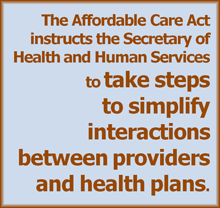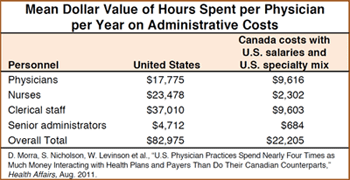Synopsis
Survey research reveals that physician practices in the United States incur nearly $83,000 in administrative costs per physician each year, nearly four times the amount spent by their Canadian counterparts. The U.S. could save almost $27.6 billion in annual health spending if administrative costs were similar to those in Canada.
The Issue

Per capita health spending in the United States is 87 percent higher than in Canada—$7,290 versus $3,895 annually. Many factors contribute to the high cost of health care in the U.S., but there is broad consensus that administrative costs stemming from interactions between physician offices and health insurance plans are a leading culprit. In contrast to physicians in Canada, which has a single-payer, predominantly public health insurance system, most U.S. practices must interact with many health plans, each with its own insurance products and rules regarding formularies, prior authorization, billing, and claims submission. For this Commonwealth Fund–supported study published in Health Affairs, researchers surveyed physicians and administrators in Ontario, Canada, about the time they spend interacting with payers. Results were compared with a national companion survey in the United States.
Key Findings
- Physician practices in the United States spent $82,975 per physician per year interacting with payers, compared with $22,205 in Ontario.
- If U.S. physicians had administrative costs similar to those of Ontario physicians, their total savings would be approximately $27.6 billion per year.
- In the U.S., nurses and medical assistants spent 20.6 hours per physician per week on administrative tasks related to health plans, nearly 10 times the 2.5 hours spent by Canadian nursing staff. U.S. nursing staff spent more time in every category of interactions, most notably obtaining prior authorizations, which accounted for 13.1 hours per physician per week.
- Very little time was spent submitting quality data in either the United States or Ontario.

Addressing the Problem
Higher administrative costs in the United States stem from a multipayer system encompassing multiple insurance products and varying rules and administrative standards. "Having multiple payers clearly generates more administrative costs than a single-payer system," the authors write. The authors add that "these costs should be balanced by possible benefits generated by such a system." However, they believe that the U.S. system could be much more efficient. In interviews with U.S. and Canadian physician leaders and administrators, the authors found widespread agreement that interactions between practices and health plans in the United States could be performed much more efficiently, reducing costs for both physicians and plans alike. For instance, standardizing transactions and conducting them electronically would reduce costs and administrative burden. In addition, provisions in the Affordable Care Act fostering the adoption of new payment methods, like bundled payment, and new ways for organizing health care delivery, like accountable care organizations, could reduce administrative costs in the long term.
About the Study
The authors surveyed physicians and business managers in Ontario, Canada, to ask them about the time they spend interacting with payers. These interactions include addressing formulary issues, seeking prior authorization for medical services that physicians believe patients need, resolving denied or improperly paid claims, and billing processes. Surveys were mailed in July 2006. Results were compared with a survey of U.S. physician practices conducted simultaneously and published in Health Affairs in 2009.
The Bottom Line
U.S. practices spend nearly $83,000 annually per physician on administrative costs, nearly four times as much as Canadian practices. Physicians agree that interactions between practices and health plans in the United States could be performed much more efficiently. If U.S. physicians had administrative costs similar to their Canadian counterparts, the U.S. could save almost $27.6 billion per year in annual health spending.


